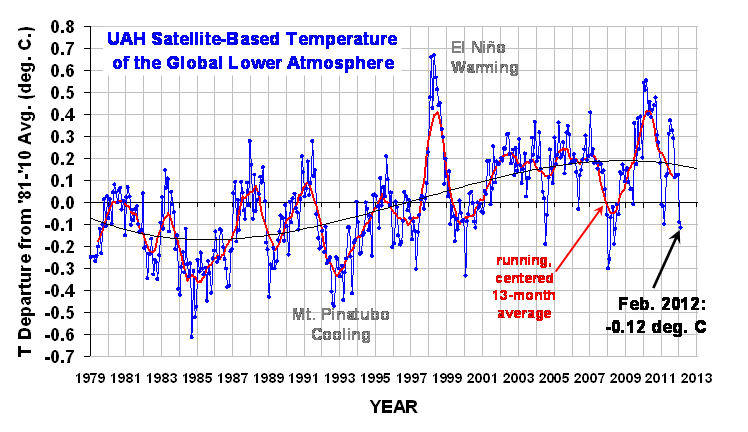The global average lower tropospheric temperature anomaly cooled a little more in February, 2012, again not unexpected for the current La Nina conditions in the tropical Pacific Ocean (click on the image for the full-size version):

The 3rd order polynomial fit to the data (courtesy of Excel) is for entertainment purposes only, and should not be construed as having any predictive value whatsoever.
Here are the monthly stats:
YR MON GLOBAL NH SH TROPICS
2011 1 -0.010 -0.055 +0.036 -0.372
2011 2 -0.020 -0.042 +0.002 -0.348
2011 3 -0.101 -0.073 -0.128 -0.342
2011 4 +0.117 +0.195 +0.039 -0.229
2011 5 +0.133 +0.145 +0.121 -0.043
2011 6 +0.315 +0.379 +0.250 +0.233
2011 7 +0.374 +0.344 +0.404 +0.204
2011 8 +0.327 +0.321 +0.332 +0.155
2011 9 +0.289 +0.304 +0.274 +0.178
2011 10 +0.116 +0.169 +0.062 -0.054
2011 11 +0.123 +0.075 +0.170 +0.024
2011 12 +0.126 +0.197 +0.055 +0.041
2012 01 -0.090 -0.057 -0.123 -0.138
2012 02 -0.116 -0.014 -0.217 -0.281
Progress continues on Version 6 of our global temperature dataset, which will have a better adjustment for drift of the satellites through the diurnal cycle, and an improved calibration procedure for the older MSU instruments (pre-1998).

 Home/Blog
Home/Blog



